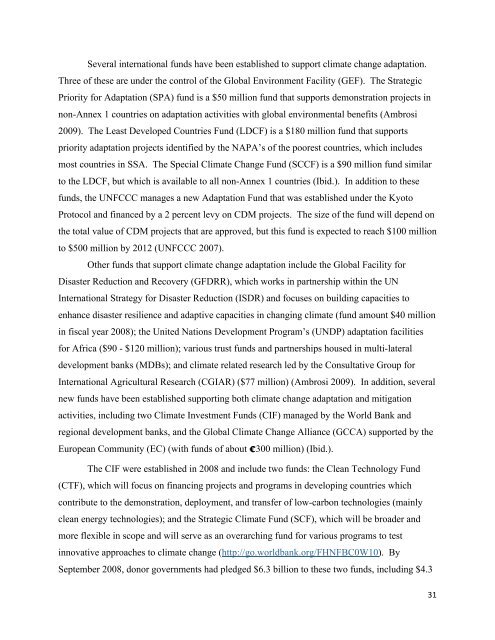The Role of Sustainable Land Management for Climate ... - CAADP
The Role of Sustainable Land Management for Climate ... - CAADP
The Role of Sustainable Land Management for Climate ... - CAADP
You also want an ePaper? Increase the reach of your titles
YUMPU automatically turns print PDFs into web optimized ePapers that Google loves.
!<br />
Several international funds have been established to support climate change adaptation.<br />
Three <strong>of</strong> these are under the control <strong>of</strong> the Global Environment Facility (GEF). <strong>The</strong> Strategic<br />
Priority <strong>for</strong> Adaptation (SPA) fund is a $50 million fund that supports demonstration projects in<br />
non-Annex 1 countries on adaptation activities with global environmental benefits (Ambrosi<br />
2009). <strong>The</strong> Least Developed Countries Fund (LDCF) is a $180 million fund that supports<br />
priority adaptation projects identified by the NAPA’s <strong>of</strong> the poorest countries, which includes<br />
most countries in SSA. <strong>The</strong> Special <strong>Climate</strong> Change Fund (SCCF) is a $90 million fund similar<br />
to the LDCF, but which is available to all non-Annex 1 countries (Ibid.). In addition to these<br />
funds, the UNFCCC manages a new Adaptation Fund that was established under the Kyoto<br />
Protocol and financed by a 2 percent levy on CDM projects. <strong>The</strong> size <strong>of</strong> the fund will depend on<br />
the total value <strong>of</strong> CDM projects that are approved, but this fund is expected to reach $100 million<br />
to $500 million by 2012 (UNFCCC 2007).<br />
Other funds that support climate change adaptation include the Global Facility <strong>for</strong><br />
Disaster Reduction and Recovery (GFDRR), which works in partnership within the UN<br />
International Strategy <strong>for</strong> Disaster Reduction (ISDR) and focuses on building capacities to<br />
enhance disaster resilience and adaptive capacities in changing climate (fund amount $40 million<br />
in fiscal year 2008); the United Nations Development Program’s (UNDP) adaptation facilities<br />
<strong>for</strong> Africa ($90 - $120 million); various trust funds and partnerships housed in multi-lateral<br />
development banks (MDBs); and climate related research led by the Consultative Group <strong>for</strong><br />
International Agricultural Research (CGIAR) ($77 million) (Ambrosi 2009). In addition, several<br />
new funds have been established supporting both climate change adaptation and mitigation<br />
activities, including two <strong>Climate</strong> Investment Funds (CIF) managed by the World Bank and<br />
regional development banks, and the Global <strong>Climate</strong> Change Alliance (GCCA) supported by the<br />
European Community (EC) (with funds <strong>of</strong> about !300 million) (Ibid.).<br />
<strong>The</strong> CIF were established in 2008 and include two funds: the Clean Technology Fund<br />
(CTF), which will focus on financing projects and programs in developing countries which<br />
contribute to the demonstration, deployment, and transfer <strong>of</strong> low-carbon technologies (mainly<br />
clean energy technologies); and the Strategic <strong>Climate</strong> Fund (SCF), which will be broader and<br />
more flexible in scope and will serve as an overarching fund <strong>for</strong> various programs to test<br />
innovative approaches to climate change (http://go.worldbank.org/FHNFBC0W10). By<br />
September 2008, donor governments had pledged $6.3 billion to these two funds, including $4.3<br />
!<br />
&$!

















